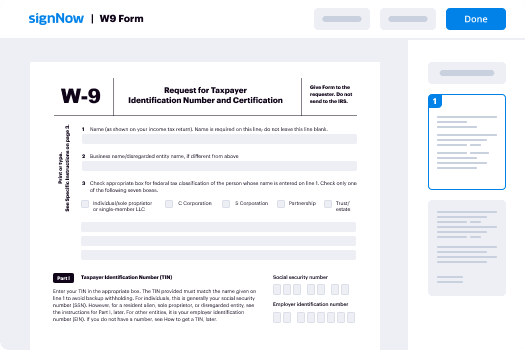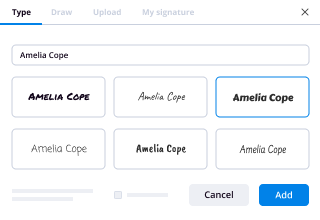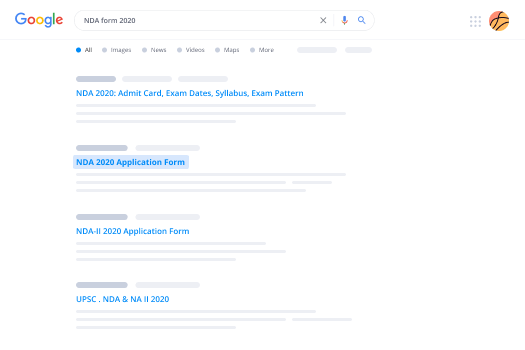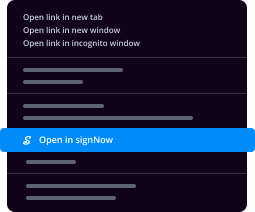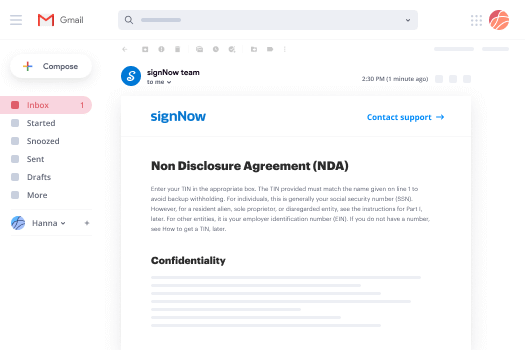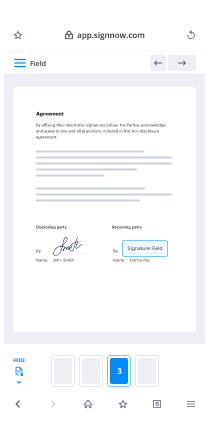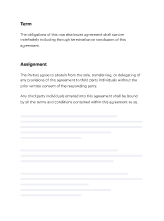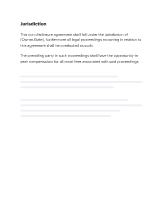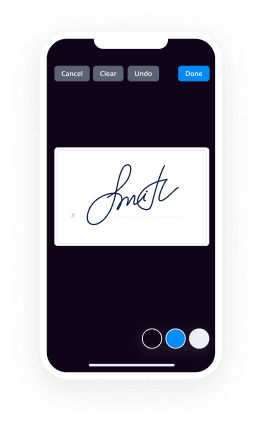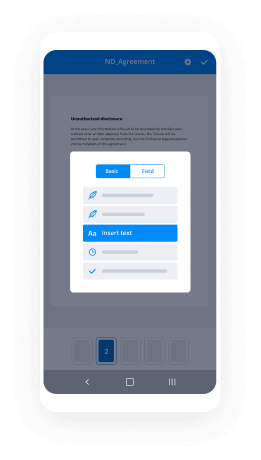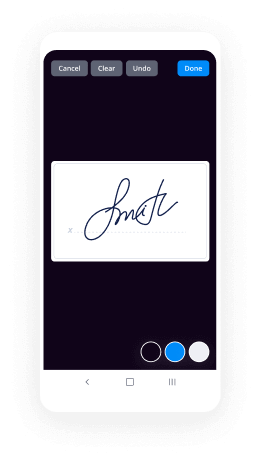Enjoy Flexible eSignature Workflows: What Makes a Document Legally Binding
- Quick to start
- Easy-to-use
- 24/7 support
Simplified document journeys for small teams and individuals




We spread the word about digital transformation
Why choose airSlate SignNow
-
Free 7-day trial. Choose the plan you need and try it risk-free.
-
Honest pricing for full-featured plans. airSlate SignNow offers subscription plans with no overages or hidden fees at renewal.
-
Enterprise-grade security. airSlate SignNow helps you comply with global security standards.







Quick-start guide: what makes a document legally binding
airSlate SignNow eSignature is a robust solution for simplifying data gathering, contract negotiation, external and internal cooperation, and streamlining decision-making processes. Signing documents in electronic format is straightforward for teams, partners and clients, and it helps your company cut down on paper wastage and unneeded budgets.
Complete the following steps listed below and find out what makes a document legally binding:
- Launch your browser and go to signnow.com.
- Join for a free trial run or log in utilizing your electronic mail or Google/Facebook credentials.
- Click User Avatar -> My Account at the top-right corner of the webpage.
- Customize your User Profile by adding personal data and changing settings.
- Create and manage your Default Signature(s).
- Return to the dashboard webpage.
- Hover over the Upload and Create button and select the appropriate option.
- Click the Prepare and Send key next to the document's title.
- Enter the name and email address of all signers in the pop-up box that opens.
- Make use of the Start adding fields menu to proceed to modify document and self sign them.
- Click SAVE AND INVITE when you're done.
- Continue to configure your eSignature workflow using extra features.
What makes a document legally binding is a good question and one that airSlate SignNow is the answer to. Check the features you and your team need for delighting your customers and companions in the best way of conducting business. eSign your first contract today!
How it works
Rate your experience
What makes a document legally binding
A document is considered legally binding when it meets specific criteria established by law. These criteria typically include the presence of an offer, acceptance, consideration, and the intention to create a legal relationship. Additionally, both parties must have the capacity to contract and the agreement must be lawful. Understanding these elements is essential for anyone looking to create or sign a document electronically.
Key elements of a legally binding document
To ensure that a document is legally binding, it must include several key elements:
- Offer: One party must present a clear proposal to another.
- Acceptance: The other party must agree to the terms of the offer without modifications.
- Consideration: There must be something of value exchanged between the parties.
- Capacity: Both parties must have the legal ability to enter into a contract.
- Legality: The subject matter of the agreement must be legal.
Steps to complete a legally binding document electronically
Completing a legally binding document electronically involves several straightforward steps:
- Choose the document: Select the appropriate template or document type you need.
- Fill in the details: Enter the required information accurately, ensuring all parties’ names and details are correct.
- Review the document: Carefully check for any errors or missing information before proceeding.
- Request signatures: Use the eSignature feature to send the document to all parties for their signatures.
- Store securely: Once signed, save the document in a secure location for future reference.
Legal use of electronically signed documents
In the United States, electronically signed documents are generally recognized as legally binding under the Electronic Signatures in Global and National Commerce (ESIGN) Act. This law ensures that electronic signatures carry the same weight as traditional handwritten signatures, provided that both parties consent to use electronic means for signing. It is important to ensure compliance with state-specific regulations that may also apply.
Security & Compliance Guidelines
When using electronic signatures, it is crucial to adhere to security and compliance guidelines to protect sensitive information. Consider the following practices:
- Use secure platforms: Choose reputable eSignature solutions that offer encryption and secure storage.
- Authenticate signers: Implement measures to verify the identity of all parties before signing.
- Maintain records: Keep detailed logs of the signing process, including timestamps and IP addresses.
- Stay informed: Regularly review compliance with applicable laws and regulations regarding electronic signatures.
Examples of using legally binding documents
Legally binding documents can be used in various scenarios, including:
- Contracts: Agreements between businesses or individuals for services or goods.
- Leases: Rental agreements between landlords and tenants.
- Employment agreements: Contracts outlining the terms of employment between an employer and employee.
- Non-disclosure agreements (NDAs): Contracts protecting confidential information shared between parties.
-
Best ROI. Our customers achieve an average 7x ROI within the first six months.
-
Scales with your use cases. From SMBs to mid-market, airSlate SignNow delivers results for businesses of all sizes.
-
Intuitive UI and API. Sign and send documents from your apps in minutes.
FAQs
-
What makes a document legally binding in the context of eSignatures?
A document is considered legally binding when it meets certain criteria, including the intent to create a legal obligation, mutual consent, and the presence of a signature. With airSlate SignNow, electronic signatures are recognized as valid under the ESIGN Act and UETA, ensuring that what makes a document legally binding is upheld in digital transactions.
-
How does airSlate SignNow ensure the legality of eSigned documents?
airSlate SignNow employs advanced security measures and complies with legal standards to ensure that eSigned documents are legally binding. This includes features like audit trails, timestamps, and secure storage, which all contribute to what makes a document legally binding in the eyes of the law.
-
What features does airSlate SignNow offer to enhance document legality?
airSlate SignNow offers features such as customizable templates, in-person signing, and multi-party signing, all of which enhance the legality of your documents. These features ensure that all parties involved understand and agree to the terms, which is crucial for what makes a document legally binding.
-
Is there a cost associated with using airSlate SignNow for legally binding documents?
Yes, airSlate SignNow offers various pricing plans that cater to different business needs. Each plan provides access to features that ensure your documents meet the criteria of what makes a document legally binding, making it a cost-effective solution for businesses.
-
Can I integrate airSlate SignNow with other applications?
Absolutely! airSlate SignNow integrates seamlessly with various applications such as Google Drive, Salesforce, and Microsoft Office. This integration enhances workflow efficiency and ensures that all documents processed through these platforms are compliant with what makes a document legally binding.
-
What are the benefits of using airSlate SignNow for eSigning?
Using airSlate SignNow for eSigning offers numerous benefits, including increased efficiency, reduced paper usage, and enhanced security. These advantages contribute to what makes a document legally binding, as they streamline the signing process while ensuring compliance with legal standards.
-
How does airSlate SignNow handle document security?
airSlate SignNow prioritizes document security by employing encryption, secure access controls, and regular audits. This commitment to security is essential for what makes a document legally binding, as it protects sensitive information and ensures the integrity of the signed documents.





























